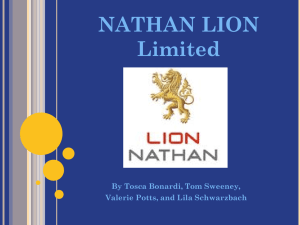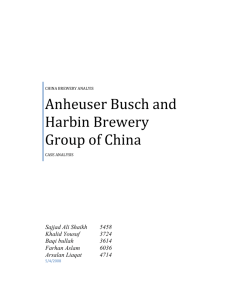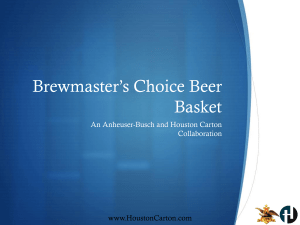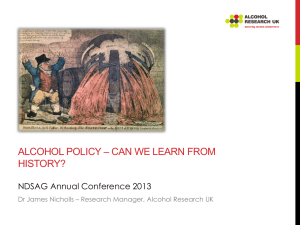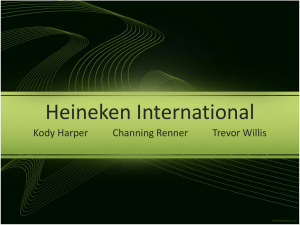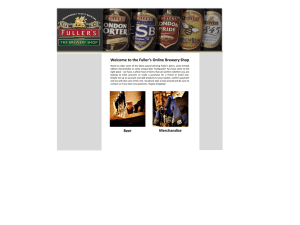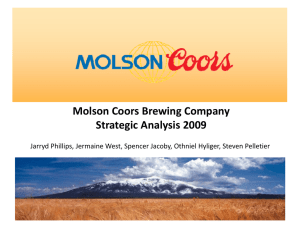File
advertisement
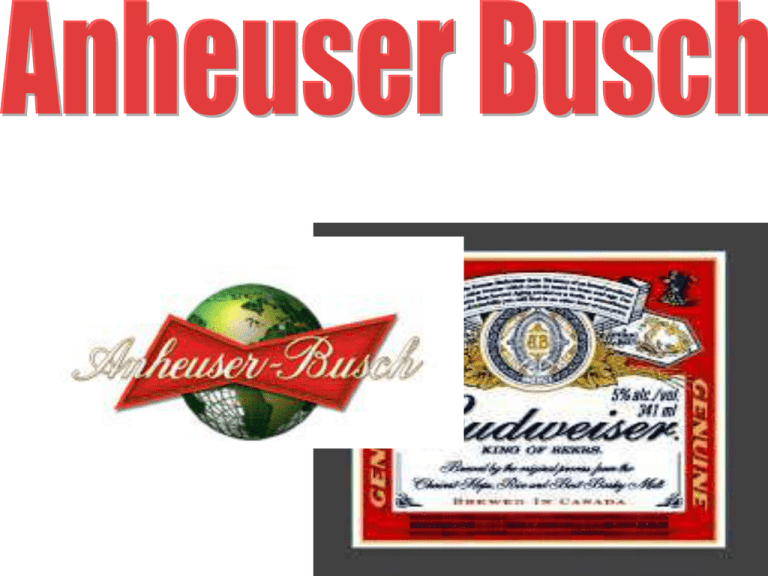
Case Analysis Sajjad Ali Shaikh Khalid Yousuf Baqi bullah Farhan Aslam Arsalan Liaqat 5458 3724 3614 6036 4714 Executive summary • Anheuser Busch is one of the leading brands of beers. company was established in 1864 in St. Louis, Missouri, United States, Anheuser Busch has grown to be one of the world’s largest beer companies, Operating 12 breweries within and 15 breweries outside of the United States, It is best known for the world’s top two selling beers, Bud Light and Budweiser current market share of the company globally is 10.8. • Chinese Beer market is an increasing market with a huge potential. Ranked 1st for volume per year but 11th rank for litres per person. Low average price for beer. Huge foreign interest on this market but foreign investment usually failed. In 2004 company acquire Harbin brewery in china. Foreign companies tend to face problem as provincial regulation are there to protect local companies and furthermore to keep the tax revenues within province. Regulatory roadblocks were designed to keep tax revenues at home. Many recognized global brands were unable to make there mark because they didn’t understand the customer taste and preference Vision: • Through all of our products, services and relationships, we will add to life’s enjoyment. Mission: • Be the world’s beer company (Products and services; Self-concept) • Enrich and entertain a global audience (Customers; Markets) • Deliver superior returns to our shareholders (Concern for survival, growth and profitability) Value: We believe in… • • • • • • • • • • Quality in everything we do. (Self-concept) Exceeding customer expectations. Trust, respect and integrity in all our relationships. (Philosophy) Continuous improvement, innovation and embracing change. (Philosophy) Teamwork and open, honest communication Each employee’s responsibility for contributing to the company’s success Creating a safe, productive and rewarding work environment. (Concern for employees) Building a high-performing, diverse workforce. Promoting the responsible consumption of our products. Preserving and protecting the environment and supporting communities where we do business. (Concern for public image) Strategic objectives: • Expansion production into China through acquisition of Chinese major beer companies • reposition its brand by catering to elite and create perception of being a premium brand • increase ownership by 27% by year 2009 • expand there operation up to there central province in order to expand there market share • In order to sustain growth and stability it needs to acquire smaller brands which would enable it to enhance its brand portfolio and expand its business under the umbrella of company name Industry Analysis • The China beer industry is the world’s largest by volume. Total domestic volume in 2005 was 307 million hectoliters, up 10.2% vs. 2004. Excellent growth has continued in 2006 with officially reported domestic volume increasing 13% through September vs. the same period, prior year. • China’s per capita beer consumption in 2005 was 23.4 liters, which was slightly lower than the estimated global average of 24.8 liters. However, China’s per capita consumption already surpasses that of Hong Kong (21.5) and Taiwan (21.1). China beer industry volume growth will slow. Industry • The chart below shows China’s Top 10 brewers by output in the first half of 2006 and it specifies the foreign ownership of each Top 10 brewer, if any: • Foreign companies tend to face problem as provincial regulation are there to protect local companies and furthermore to keep the tax revenues within province. Regulatory roadblocks were designed to keep tax revenues at home. Many recognized global brands were unable to make there mark because they didn’t understand the customer taste and preference which is clearly visible as they hold 0.5 percent of Chinese market. PEST ANALYSIS • • • • • • • • • • • Political and legal Decentralized power structure Unstated hierarchy of power High tax on transportation Big power of the local and provincial authorities Logistics laws Economical Important growth of China economy Huge and fragmented market Increase of urbanization rate • • • • • • • • • Social Low income and standard of living Technological Poor level of infrastructure Environmental Development of urban areas Reduce emissions of carbon dioxide Recyclage of bottles Obligation to share technology and knowledge for foreign firms Market Share In China STRATEGIC GROUPS High CRSB Tsingtao Yanjinj In-Bev Led Market Share Harbin Chongpi Other Local Brew Low Few Product Range Many Global Market Anheuser-Busch, 10.80% SABM iller, 8.90% Others, 43.00% Interbrew, 8.40% Heineken, 7.60% Carlsberg, 5.70% Kirin, 2.20% Coors, 2.6 Ambev, 4.70% Grupo M odelo, 2.80% Scottish& Newcastle, 3.30% : STRATEGIC GROUPS Porter’s Five Forces • Threats of new entrants: – High barriers to entry: • Fragmented market • Distribution networks • Government Regulations – Economies of scale in marketing, production and distribution. • Rivalry (price competition has been decreasing): – Increasing competition from imported beers (however, national brewers own part of these breweries). – 2,200 wholesalers and 560,000 retail establishments. – Creative and enticing advertising by majors. – Growing popularity of micro-breweries and other craft-beers. – Alternative: expansion to super-premium beers and other segments with lower demand elasticity. • Substitutes: – Growth in: • Premixed drinks • Alternative malt beverage • Alternative non-alcoholic drinks (from juices to mineral water) – However, beer remains the largest drink sector. • Buyer’s Bargaining Power: – It changes from segment to segment, but in general: • Low switching costs • Brand loyalty • Increasing health conscience • However, for craft-beers, which are perceived as having higher quality, these characteristics may not always hold. • Suppliers’ Bargaining Power: – Most supplies come from competitive industries which are more fragmented than the beer industry. • Farmers • Labor (the case of unionized labor) – The more consolidated supplier is that one supplying bottles/cans. Key Success Factors • Low cost structure (Scale of economies and learning) • Effective marketing & advertising strategy to expanded market share • Successful brand loyalty and recognition • Product innovation and production efficiency (packaging and automation) • International expansion to countries with increasing consumption trends • Strategic price increases and premium pricing Driving Forces • Marketing innovation - thanks to a rather uniform character of the product, breweries are trying to find other possibilities of differentiation, which is based mainly on building the brand assisted by advertising. • Long-term industry growth rate –In the decade between 1988 and 1998 the 10 largest brewers hardly arose from 35.8% to 37.6%. Over the last five years this development has accelerated strongly, the 10 largest increased by nearly 20% and have now 57% of the global market. • Cost efficiency –The price of the beer does not grow respectively with the price of supplies, breweries are forced to develop more effective ways of operation. CPM Critical Success Factors Weight Anheuser-Busch Rating Score CRE (SABMiller) Rating Score Tsingtao Rating Score 0.15 4 0.6 3 0.45 3 0.45 0.1 4 0.4 2 0.2 4 0.4 0.15 3 0.45 3 0.45 3 0.45 0.1 3 0.3 4 0.4 3 0.3 Organizational Culture 0.1 4 0.4 4 0.4 4 0.4 Revenue Generation 0.25 3 0.75 4 1 3 0.75 0.15 4 0.6 2 0.3 2 0.3 Low cost structure Effective marketing Successful brand Strategic price International expansion TOTAL 1 3.5 3.2 3.05 EFE (EXTERNAL ANALYSIS FACTORS) KEY EXTERNAL FACTORS WEIGHT RATING WEIGHTED SCORE Opportunities 1. Emerging pub culture and positive trend to premium beer 0.05 3 0.15 0.2 0.1 4 4 0.8 0.4 4. Growing economy coupled with large market potential 0.1 2 0.2 5. Micro-brewery marketing through additional partnership 0.05 2 0.1 2. Increase brand loyalty 3. Develop event sponsorships Threats 1. Price sensitivity due to per capita income 0.1 2 0.2 2. Poor infrastructure as an obstacle for efficient distribution system 0.15 2 0.3 3. Corruption and political interference from government 0.05 2 0.1 4. Unstable energy and fuel cost 0.1 1 0.1 5. Lack of centralization in China’s government 0.1 1 0.1 TOTAL 1 2.45 IFE KEY INTERNAL FACTORS WEIGHT RATING WEIGHTED SCORE Internal Strengths 1. High level of Expertise in the beer industry coupled with financial strength 2. Global reputation through brand recognition and uniqueness in taste 3. High level of operating efficiency and quality consistency 4. Recruitment policy focusing on highly capable employees 0.20 4 0.80 0.05 4 0.20 0.15 4 0.60 0.05 3 0.15 5. Ability to select partners in joint-venture business 0.10 3 0.30 Internal Weaknesses 1. Language barrier and lack of understanding of culture 0.10 2 0.20 2. Lack of decentralization is an obstacle for expedient decision-making in regional market 0.05 1 0.05 3. Limited brand awareness among Chinese beer consumers 0.10 2 0.20 4. Inability to distribute fresh beer across the country 5. Lack of emphasis on economy beer segment 0.10 1 0.10 0.10 1 0.10 TOTAL 1.00 2.70 TOWS Opportunities- O Strengths- S Weaknesses- W 1. High level of expertise in the beer industry coupled with financial strength 2. High level of operating efficiency and quality consistency 3. Ability to select partners in joint- venture business SO Strategies 1. Language barrier and lack of understanding of culture 2. Limited brand awareness among Chinese beer customers 3. Lack of emphasis on economy beer segment 1. Increase brand loyalty 2. Develop event sponsorship 3. Growing economy coupled with large market potential 1. Build beer factories in major Chinese markets (S1 , O3 ) 2. Increase market share ( S 3, O2 ) Threats – T ST Strategies 1. Poor infrastructure as an 1. Implement optimal production obstacle for efficient techniques to meet market distribution system requirements ( S2, T2 ) 2. Develop partnership with 2. Price sensitivity per capita local manufacturers ( S 3, T 3) income 3. Corruption and political interference from government WO Strategies 1. Increase brand W 2, O 1, O2) recognition ( WT Strategies 1. Employ local managers ( W 1, T 3) 2. Acquire small local beer manufactures ( W 3, T 1) SPACE Financial Strength ( FS) Ratings Return on Investment Leverage Liquidity Working Capital Cash Flow Ease of exit from market Risk involved in business 6 4 4 5 5 3 3 Total 30 Industry Strength ( IS) Growth Potential Profit Potential Technological Know- how Resource Utilization Capital Intensity Ease of entry into market Productivity, Capacity utilization 4 5 6 5 5 2 5 Environmental Stability ( ES ) Technological Changes Rate of Inflation Demand Variability Price range of competition products Barriers to entry into market Competitive pressure Price elasticity of demand -2 -4 -3 -4 -5 -5 -3 Total -26 Competitive Advantage ( CA) Market Share Product quality Product life cycle Customer loyalty Competition’s capacity utilization Technological Know- how Control over suppliers and distribution -3 -1 -3 -2 -5 -1 -2 • • • • • • • • • FS Average is 30/7 = 4.29 IS Average is 32/7 = 4.57 ES Average is -26/ 7 =-3.71 CA Average is -17/ 7 =-2.43 Directional Vector Coordinates: x-axis: CA Average + IS Average =-2. 43 + 4.47 = 2.04 y-axis: FS Average + ES Average =4.29-3.71= 0.58 SPACE Matrix FS Aggressive Conservative (2.04, 0.58) IS CA -3 -2 -1 1 2 3 Competitive Defensive ES ISSUES FACED • • • • Fragmented Market Price wars Regulations Distribution problem Financial Ratios Company Industry S&P 500 Current Ratio (MRQ) 0.89 1.09 1.63 LT Debt to Equity (MRQ) 2.95 1.94 0.60 Total Debt to Equity (MRQ) 2.95 2.01 0.78 Interest Coverage (TTM) 6.25 6.50 14.52 Quick Ratio (MRQ) 0.57 0.57 Company 1.12 Industry S&P 500 Return On Assets (TTM) 8.57 7.38 8.51 Return On Assets - 5 Yr. Avg. 9.47 8.46 8.02 Return On Investment (TTM) 9.97 9.24 12.13 Return On Investment - 5 Yr. Avg. 10.85 10.30 11.65 Return On Equity (TTM) Return On Equity - 5 Yr. Avg. 60.54 62.23 39.40 20.38 43.37 19.46 Alternative Strategies • • • • Build beer factories in major Chinese markets Increase market share Develop partnership with local manufacturers Acquire small local beer manufactures to expand business and manage distribution

